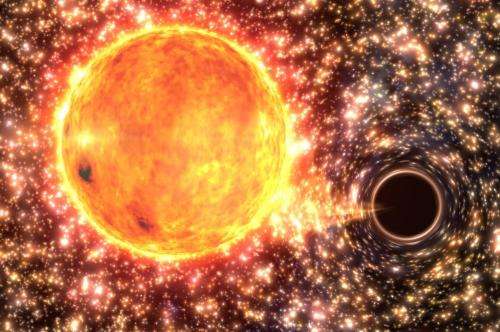Black holes growing faster than expected

(Phys.org)—Astronomers from Swinburne University of Technology have discovered how supermassive black holes grow - and it's not what was expected.
For years, scientists had believed that supermassive black holes, located at the centres of galaxies, increased their mass in step with the growth of their host galaxy. However, new observations have revealed a dramatically different behaviour.
"Black holes have been growing much faster than we thought," Professor Alister Graham from Swinburne's Centre for Astrophysics and Supercomputing said.
Within galaxies, there is a competition of sorts for the available gas; for either the formation of new stars or feeding the central black hole.
For more than a decade the leading models and theories have assigned a fixed fraction of the gas to each process, effectively preserving the ratio of black hole mass to galaxy mass. New research to be published in The Astrophysical Journal reveals that this approach needs to be changed.
"We now know that each ten-fold increase of a galaxy's stellar mass is associated with a much larger 100-fold increase in its black hole mass," Professor Graham said. "This has widespread implications for our understanding of galaxy and black hole coevolution."
The researchers have also found the opposite behaviour to exist among the tightly packed clusters of stars that are observed at the centres of smaller galaxies and in disk galaxies like our Milky Way.
"The smaller the galaxy, the greater the fraction of stars in these dense, compact clusters," Swinburne researcher Dr Nicholas Scott said. "In the lower mass galaxies the star clusters, which can contain up to millions of stars, really dominate over the black holes."
Previously it was thought that the star clusters contained a constant 0.2 per cent of the galaxy mass.
The research also appears to have solved a long-standing mystery in astronomy. 'Intermediate mass' black holes with masses between that of a single star and one million stars have been remarkably elusive.
The new research predicts that numerous galaxies already known to harbour a black hole - albeit of a currently unknown mass - should contain these missing `intermediate mass' black holes.
"These may be big enough to be seen by the new generation of extremely large telescopes," Dr Scott said.
Professor Graham said these black holes were still capable of readily devouring any stars and their potential planets if they ventured too close.
"Black holes are effectively gravitational prisons and compactors, and this may have been the fate of many past solar systems," Professor Graham said. "Indeed, such a cosmic dance will contribute at some level to the transformation of nuclear star clusters into massive black holes."
The researchers combined observations from the Hubble Space Telescope, the European Very Large Telescope in Chile and the Keck Telescope in Hawaii to create the largest sample to date of galaxies with reliable star cluster and supermassive black hole mass measurements.
Journal information: Astrophysical Journal
Provided by Swinburne University of Technology



















